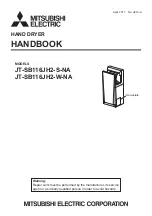
─
11
─
10. Troubleshooting
Work precautions
• When servicing, reproduce the malfunction two or three times before starting repairs.
• When servicing, always take care to keep proper footing.
• Before starting the service, always unplug the power cord from the outlet, or turn off the circuit breaker when
no power cord plug is provided. Sufficient care must be taken to avoid electric shock or injury.
• Make sure to connect the power supply wires correctly.
• When removing the circuit board, always hold it at both ends and remove carefully so as not to apply force
to the surface mounted parts.
• When removing the circuit board, be careful of the metal edges on the board.
• When removing or inserting the connectors for the circuit board, hold the entire housing section. Never pull
on the lead wires.
• When circuit board failure is considered to be a cause, check closely for any broken section on the copper
foil patterns, burning or discoloration of parts.
• After replacing a circuit board, make sure to restore the same settings as before the replacement.
The part names in the text are standardized with the part names in the parts catalog. (There are some
exceptions.)
Purpose
Device
Overcurrent protection
Current fuse
Protection against an excessive
temperature rise of the heater parts
Thermal fuse
Protection against an excessive
temperature rise of the blower parts
Thermal fuse
Motor lock protection
• Current detection circuit
( Detects abnormal current caused by the motor lock, and stops the
power to the motor.)
• Current fuse
(1) Table of the safety devices
Model name of the circuit boards
JT-SB116JH2-S-NA JT-SB116JH2-W-NA
Power circuit board
JT-34P1H
Filter circuit board
JT-34F
Control circuit board
JT-30M10
JT-30M10A
Light receiving circuit board
JT-30S1R
Sensor circuit board
JT-30S2R
Sensor circuit board
JT-30S3R
Display circuit board
JT-30S5R
(2) Troubleshooting












































